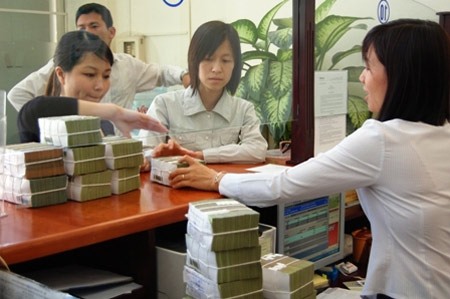 Economy
Economy

Deputy Prime Minister Vương Đình Huệ has recently instructed relevant authorities to scrutinise the possible removal of the deposit interest rate cap on short-term deposits.
 |
| Relevant authorities are required to scrutinise the possible removal of the deposit interest rate cap on short-term deposits. - Photo vaytinchaphn.net |
HÀ NỘI – Deputy Prime Minister Vương Đình Huệ has recently instructed relevant authorities to scrutinise the possible removal of the deposit interest rate cap on short-term deposits.
Việt Nam currently still applies an interest rate cap of 5.5 per cent for short-term deposits of 1-6 months. The rates for longer terms are floating.
The cap regulation has been imposed since 2010 when commercial banks, especially ailing ones with poor liquidity, took part in a race to increase deposit interest rates to lure depositors, causing a sharp rise in lending interest rates.
Industry insiders and experts have proposed removing the deposit interest rate cap several times, saying that the cap regulation is an administrative measure and it does not follow international rules so it should be removed at a suitable time.
Banking expert Cấn Văn Lực said that the cap regulation has been imposed for the past six years and now is a suitable time for the central bank to remove it.
He said that currently there is almost no unhealthy competition in deposit interest rates among banks thanks to their good liquidity. The loan deposit ratio (LDR) of the banking system has also improved, staying at more than 80 per cent.
The interest rate cap regulation, therefore, is unnecessary, Lực said.
He also said the Government should reduce its administrative measures in managing the economy in general, and the monetary and finance industry in particular, to meet international rules.
Echoing Lực, economist Nguyễn Minh Phong said that there would be no problem if the central bank removes the cap at this time, adding that the removal would help commercial banks lure more deposits in the context that the country is boosting lending.
Analysts from the Việt Nam Institute for Economic and Policy Research (VEPR) also proposed to fully remove the cap soon or apply the rate cap only for deposits of less than one month so that the market itself could adjust flexibly, balancing capital demand and supply.
It is time to consider removing the cap as the country currently has the necessary conditions for its removal: inflation remains low and liquidity in the banking system is good, according to economist Nguyễn Trí Hiếu.
Some, however, are concerned that removing the cap could cause a resumption of the high inflation seen in previous years. However, Hiếu said that he was not worried about the threat, explaining that the adjustment of interest rates, if it occurred, would be within certain limits.
Besides, he said, the central bank could use other measures such as the refinancing rate, discount rate, overnight rate and reserve requirements to control the market.
He said that central banks around the world often use the three key tools of open market operations (OMO), refinancing rates and reserve requirements to execute monetary policies. Therefore, eventually, the State Bank of Việt Nam also has to use the tools to manage the banking system to meet international rules, especially as Việt Nam integrates more deeply into the global economy.
Though agreeing about the removal of the cap regulation, some experts have said that caution is necessary and a timeline for the removal should be taken.
In the opinion of Trần Du Lịch, a member of the National Financial and Monetary Policy Advisory Council, the application of the cap over a long time is not good, especially when Việt Nam eventually aims to manage banking activities and interest rates according to market principles.
After the restructuring period of credit institutions in 2011-15, the performance of commercial banks have become pretty good. Besides, four State-owned banks have recently cut deposit rates. It shows that liquidity in the banking system is good so relevant authorities could consider removing the deposit interest rate cap.
Besides, Việt Nam is deeply integrating into the global economy so the country needs to apply international rules through the reduction of using administrative measures to intervene in the monetary market.
However, Lich said, the removal should not be made immediately. He suggested that early next year might be a suitable time, after relevant authorities had scrutinised the potential impacts of the removal and closely monitored the market over the next several months.
Another member of the National Financial and Monetary Policy Advisory Council, Võ Trí Thành, said that the removal of the cap must be considered carefully and if taken, certain itineraries should be applied to avoid disorder, ensuring the stability and health of the banking and finance system.
It must be also implemented in co-ordination with other monetary and fiscal policies, Thành said. - VNS




